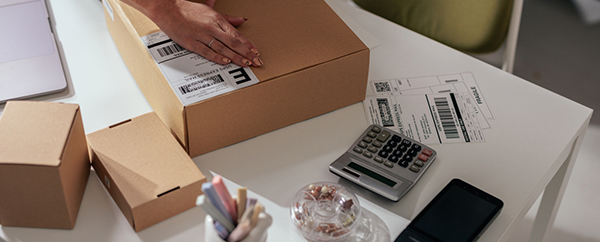
Packaging might seem straightforward — just grab a box, pack it up and ship it out. However, for businesses, it’s rarely that simple. Packaging oversights, like using oversized boxes or flimsy materials, can result in more than just damaged products or dissatisfied customers; they represent hidden costs that can quietly nibble away at your profits.
It’s not just materials or shipping fees, either. Wasted space, damaged goods and subpar customer experiences all come at a price. The good news is that it’s possible to cut costs with the right strategies.
Packaging is more than a tool for getting your product from Point A to Point B. It’s the first impression of your brand, the shield that protects your goods and yes, a critical factor in managing your costs. So, let’s unpack the hidden price tag of every box — and how to maximize your profits.
Your first step to savings
Many businesses don’t realize how much they’re spending — or wasting — on packaging until they dig into the details. So, before you can cut costs, you need to know where your dollars are going. A quick audit of your current packaging process can help you pinpoint inefficiencies and identify opportunities for improvement. Some things to consider:
- Are you overpacking? Using oversized boxes with unnecessary filler for lightweight products means you’re paying extra for air and wasted materials.
- Are your materials doing their job? If your products aren’t making it to customers in one piece, you’re losing money on returns and replacements.
- How much are you really spending? Beyond the box, tape and padding materials, think about storage, labor and increased shipping fees tied to package dimensions.
This might seem like a hassle, but knowing where your money is going is the first step to keeping more of it.
Cutting costs without cutting corners
Once you’ve identified the gaps in your packaging process, it’s time to address them. Here are some ways to save money while keeping your products safe and your customers happy.
Right-size your packages
Think of right-sizing like tailoring a suit — it’s all about the fit. A well-sized box not only looks professional but reduces the need for extra filler, cuts material waste and avoids unnecessary shipping costs resulting from oversized dimensions. Customers will also appreciate not having to wrestle with a sea of packaging peanuts to get to their product.
Rethink your materials
Eco-friendly packaging isn’t just a nice-to-have anymore. Affordable options like recycled cardboard, compostable mailers and biodegradable fillers reduce waste and appeal to eco-conscious consumers. Plus, sustainable packaging could even boost your brand image.
Related: The smart path to sustainable packaging solutions
Share the load
Collaborating with other businesses in your area or industry to buy materials in bulk or share shipping space can help unlock discounts and efficiencies. These partnerships make it easier for smaller businesses to access cost savings typically reserved for larger operations.
Protect what matters
Even the best packaging can’t prevent every mishap, so, when things go wrong, insurance steps in to soften the blow. It’s not just about covering replacement costs — it’s about showing customers that you’re reliable and proactive, giving your customers confidence that you’ll make things right. And knowing you have a safety net allows you to focus on growth without fearing the unexpected.
Related: Understanding parcel insurance
Invest in quality control
Regularly inspect your packaging materials and processes to catch issues before they arise. A little diligence can prevent a lot of headaches and unnecessary expenses.
How packaging is a brand experience
Packaging is also part of your customer experience so, reducing costs shouldn’t mean sacrificing quality. Yes, saving money is critical but more importantly, your packaging needs to protect your products and reflect your brand.
The moment a package lands on your customer’s doorstep, it speaks volumes about your business. A sturdy, thoughtfully designed package sends a message: you care about quality. On the flip side, cheap or flimsy packaging can make customers question whether your product is worth their money.
Related: How to turn a shipping mishap into a customer loyalty win
Cheap packaging may save a few cents upfront, but keep in mind that damaged goods don’t just cost you the price of a replacement — they cost you trust. And once trust is broken, it’s hard to rebuild.
Keeping your packaging efficient
Once you’ve optimized your packaging process, don’t stop there. It’s not a one-and-done deal. Customer expectations, shipping costs and materials evolve, and staying ahead requires regular tweaks to your process.
Track key metrics
Pay attention to how your packaging is performing. Monitoring key performance indicators like the cost of packaging per shipment, customer feedback on unboxing experiences and damage rates will help you determine where to tweak and improve. These metrics matter.
Embrace change
Even if your packaging process feels solid, there’s always room to grow. Periodic audits, new materials and feedback from your customers can help you refine your approach. Don’t let what worked yesterday hold you back from what could be better tomorrow.
Why evaluating your packaging is worth the effort
Packaging isn’t just about containing your product — it’s about delivering on your brand’s promise. Efficient, thoughtful packaging protects your profits, strengthens your reputation and leaves a lasting impression on your customers.
When you get it right, packaging becomes a powerful tool — not just for saving money, but for building trust and loyalty with your customers. And when things go wrong? Having the right insurance in place ensures you can recover quickly and keep moving forward. Your packages deliver products, but they should deliver peace of mind, too.
At the end of the day, great packaging isn’t just a cost; it’s an investment in your business’s success. Let’s make sure every box you send out is worth every penny — and then some.

